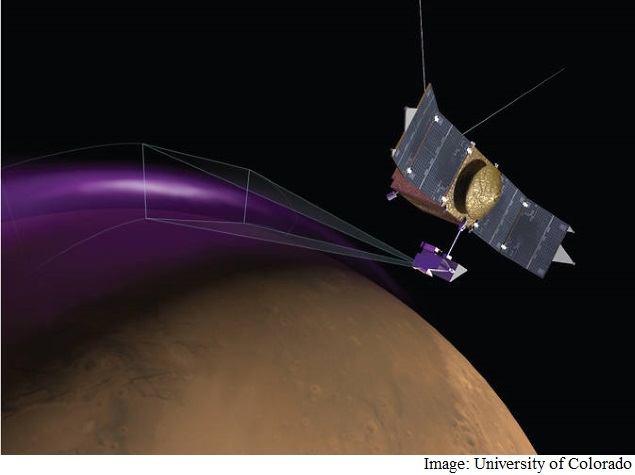- Home
- Science
- Science News
- Nasa's MAVEN Spacecraft Detects Mysterious Dust Cloud on Mars
Nasa's MAVEN Spacecraft Detects Mysterious Dust Cloud on Mars

The presence of the dust at orbital altitudes from 150 km to 300 km above the surface was not predicted earlier.
Although the source and composition of the dust are unknown, there is no hazard to MAVEN and other spacecraft orbiting Mars.
"If the dust originates from the atmosphere, this suggests we are missing some fundamental process in the Martian atmosphere," said Laila Andersson from the University of Colorado's Laboratory for Atmospherics and Space Physics (CU LASP), Boulder, Colorado.
It is unknown if the cloud is a temporary phenomenon or something long lasting.
The cloud density is greatest at lower altitudes.
However, even in the densest areas, it is still very thin.
So far, no indication of its presence has been seen in observations from any of the other MAVEN instruments.
Possible sources for the observed dust include dust wafted up from the atmosphere; dust coming from Phobos and Deimos, the two moons of Mars; dust moving in the solar wind away from the sun; or debris orbiting the sun from comets.
However, no known process on Mars can explain the appearance of dust in the observed locations from any of these sources.
Earlier, MAVEN's Imaging Ultraviolet Spectrograph (IUVS) observed what scientists have named "Christmas lights".
"What is especially surprising about the aurora we saw is how deep in the atmosphere it occurs - much deeper than at Earth or elsewhere on Mars," added Arnaud Stiepen from the University of Colorado.
The source of the energetic particles appears to be the sun.
Billions of years ago, Mars lost a global protective magnetic field like Earth has, so solar particles can directly strike the atmosphere.
The electrons producing the aurora have about 100 times more energy than you get from a spark of house current, so they can penetrate deeply in the atmosphere.
The findings were presented at the 46th Lunar and Planetary Science Conference in the Woodlands, Texas recently.
For the latest tech news and reviews, follow Gadgets 360 on X, Facebook, WhatsApp, Threads and Google News. For the latest videos on gadgets and tech, subscribe to our YouTube channel. If you want to know everything about top influencers, follow our in-house Who'sThat360 on Instagram and YouTube.
Related Stories
- Samsung Galaxy Unpacked 2025
- ChatGPT
- Redmi Note 14 Pro+
- iPhone 16
- Apple Vision Pro
- Oneplus 12
- OnePlus Nord CE 3 Lite 5G
- iPhone 13
- Xiaomi 14 Pro
- Oppo Find N3
- Tecno Spark Go (2023)
- Realme V30
- Best Phones Under 25000
- Samsung Galaxy S24 Series
- Cryptocurrency
- iQoo 12
- Samsung Galaxy S24 Ultra
- Giottus
- Samsung Galaxy Z Flip 5
- Apple 'Scary Fast'
- Housefull 5
- GoPro Hero 12 Black Review
- Invincible Season 2
- JioGlass
- HD Ready TV
- Laptop Under 50000
- Smartwatch Under 10000
- Latest Mobile Phones
- Compare Phones
- Nubia Z70S Ultra
- Meizu Note 16
- Meizu Note 16 Pro
- Sony Xperia 1 VII
- OnePlus 13s
- Samsung Galaxy S25 Edge
- Vivo Y300 GT
- Samsung Galaxy F56 5G
- Lenovo Legion 9i (18”, 10)
- Alienware 16X Aurora
- OnePlus Pad 2 Pro
- Amazon Kindle Paperwhite (12th Gen)
- boAt Storm Infinity Plus
- Moto Watch Fit
- Xiaomi QLED TV FX Pro (55-inch)
- Xiaomi QLED TV FX Pro
- Asus ROG Ally
- Nintendo Switch Lite
- Toshiba 1.8 Ton 5 Star Inverter Split AC (RAS-24TKCV5G-INZ / RAS-24TACV5G-INZ)
- Toshiba 1.5 Ton 5 Star Inverter Split AC (RAS-18PKCV2G-IN / RAS-18PACV2G-IN)

















